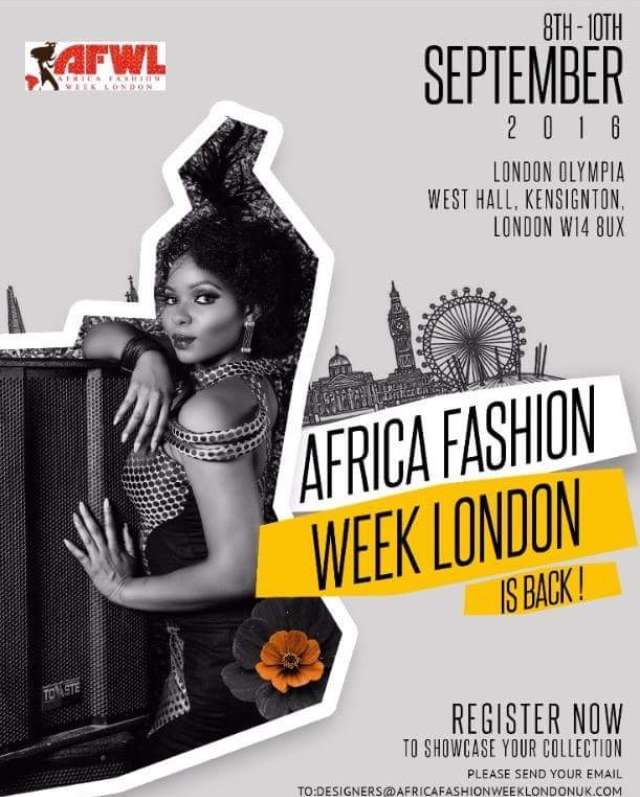
Africa Fashion Week London (AFWL) 2016 opens at London Olympia in a matter of days (9-10 September). Now in its sixth year, the event promises to be bigger, badder and more stylish than ever. The event champions new and emerging designers – many of whom incorporate heritage and contemporary designs into their fashion lines. The event includes exclusive catwalk appearances, and brand names such as Bestow Elan – developed by Erzumah Ackerson – a former London College of Fashion student.
AFWL was created by RonkeAdemiluyi and is the largest catwalk event of ‘African’ and ‘African’-inspired design across Europe. I went for the second time last year and was impressed by the entrepreneurial spirit and business acumen many of the companies exhibited.Check out my thoughts from the 2015 show and if you.
In the 12 months since I last attended AFWL 2014. Two trends have emerged that – for me – are indicators that fashion inspired by Africa’s many cultures and people is coming into its own.
The first focuses on the professionalism of exhibitors at the two-day event in August and the second trend looks at factors that are shaping the direction of designs inspired by the Continent.
Business-savvy exhibitors
Exhibitors at the London Olympia hall were engaging, business and marketing savvy, and knowledgeable.
You may say that these observations should go without saying, but I have lost count of the number of times I have been on the receiving end of a disinterested retailer unwilling to show flexibility when selling and marketing their products.
Exhibitors – such as Ricoton and Quincy’s Collection – excelled in making the most of their pitches at AFWL 2015. By constantly changing displays and replenishing stock once they sold items, they attracted repeat custom and helped shoppers unearth previously inconspicuous gems.
Nomade’s was awesome at self-branding. Dakar-born designer Bintu was literally willing to sell me the shirt on her back when I requested a gorgeous but sold-out lemon-coloured top.
And she lost no time in taking that opportunity to change into another one of her designs and strut her stuff around the hall as a human advert.
Branded bags from the likes of Nomade’s and fashion label Victoria Grace emphasised to me that these gimmicks are not just the preserve of high-street retailers. And the gift-boxed socks from Ghanaian business owner Karina of Fabric Gateaux were on point!
Africa on the map
Second in my top two was the indelible mark African-inspired fashion is making globally. I noticed there were a lot more exhibitors this year compared to 2014. And while last year seemed to attract primarily exhibitors from West Africa, I felt the 2015 AFWL event organisers had cast their nets wider.
Official AFWL figures record 70 exhibitors in 2015, a 40% increase on the previous year, while representation per African country more than doubled from an average of eight in 2014 to an average of 18 in 2015.
Thanks to the presence of the Kwazulu Natal Fashion Council (KZNFC), there was an increased South African presence. But other countries filling the hall included those from Ghana, Kenya, Sierra Leone, Nigeria, Gambia, Senegal, and Uganda – with many making their debut at the 2015 show.
Concerns over the dominance of China in the proliferation of mass produced African clothes was also challenged at the show. African designers are reshaping that trend and are collaborating on an equal footing with Asian creators.
Dumile and Tivamile Dlamini of Lihiya are one such example. The sisters work with indigenous people of Republic of China, Taiwan and Tibet, using textiles from the Kingdom of Swaziland.
Contrary to recent media reports about the mass migration of non-Europeans to Europe, some African designers at AFWL 2015 showed that the trend worked both ways.
On more than a few occasions, I noticed that some of the African exhibitors who were born in the West had chosen to establish businesses in the Motherland but were promoting their wares on a global stage.
Working it out
One such example is British-born designer Jennifer of Victoria Grace who cut her teeth working at fashion houses including Condé Nast Vogue UK and Calvin Klein London. She established herself as a Lagos-based designer with a global customer base. Her business approach reminds me of words from Caleb Tamfu, of civil society organisation Africa 2:0, who said that one person’s obstacle is another man’s opportunity, (see Doing Business the ‘African’ Way).
Jennifer was not beaten by Nigeria’s challenging infrastructure which made producing standard sized dresses for a global market difficult. Instead she worked with what she had and produced a series of dress styles that can be worn by a UK size 4 to a size 14.
Jennifer’s range was showcased on the AFWL 2015 catwalk.
“In Nigeria, the infrastructure is quite poor and also the skilled labour is not on the level of expertise you need for an international market,” Jennifer told MisBeee. “It means we have the challenges of sometimes poor or non-uniform production because we are not able at this time to give small, medium, and large sizes that are exactly the same. For us to play a role in the international market, the Victoria Grace label has made a collection that fits size 4 to 14.”
This two-day exhibition in August was a chance for me also to explore the rich tapestry that is ‘African’-inspired design, and ask designers what ‘African’ fashion means to them. It was also a chance to explore if it is time for us to relinquish the ‘African’ fashion label in favour of a more regionalised showcase of designs inspired by Africa’s many cultural groups.
Check out the responses here.
And find out what Ghanaian afrobeats artist Atumpan thought of the event here.
To find out more about the event, visit www.africafashionweeklondon.com
Author: Kirsty Osei-Bempong is a journalist and blogger who writes primarily on aspects of West African cultures, arts and history. Her work can be found on www.misbeee.blogspot.co.uk where this article was originally published.





